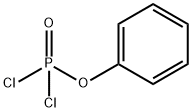
Фенил дихлорфосфа
- английское имяPhenyl dichlorophosphate
- CAS №770-12-7
- CBNumberCB1669062
- ФормулаC6H5Cl2O2P
- мольный вес210.98
- EINECS212-220-6
- номер MDLMFCD00002067
- файл Mol770-12-7.mol
| Температура плавления | -1 °C |
| Температура кипения | 241-243 °C (lit.) |
| плотность | 1.412 g/mL at 25 °C (lit.) |
| давление пара | 2.33Pa at 25℃ |
| показатель преломления | n |
| Fp | >230 °F |
| температура хранения | 2-8°C |
| растворимость | soluble in Chloroform |
| форма | Liquid |
| цвет | Clear colorless to very slightly brown |
| Растворимость в воде | Decomposes |
| Чувствительный | Moisture Sensitive |
| Мерк | 14,7282 |
| БРН | 511863 |
| Стабильность | Moisture Sensitive |
| ИнЧИКей | TXFOLHZMICYNRM-UHFFFAOYSA-N |
| Справочник по базе данных CAS | 770-12-7(CAS DataBase Reference) |
| FDA UNII | AE85WW9S5Z |
| Справочник по химии NIST | Phosphorodichloridic acid, phenyl ester(770-12-7) |
| Система регистрации веществ EPA | Phosphorodichloridic acid, phenyl ester (770-12-7) |
| UNSPSC Code | 12352100 |
| NACRES | NA.22 |
| Коды опасности | C | |||||||||
| Заявления о рисках | 34-37 | |||||||||
| Заявления о безопасности | 26-36/37/39-45 | |||||||||
| РИДАДР | UN 3265 8/PG 2 | |||||||||
| WGK Германия | 3 | |||||||||
| RTECS | TD4393000 | |||||||||
| F | 10 | |||||||||
| TSCA | Yes | |||||||||
| Класс опасности | 8 | |||||||||
| Группа упаковки | II | |||||||||
| кода HS | 29209085 | |||||||||
| NFPA 704: |
|
рисовальное письмо(GHS)
-
рисовальное письмо(GHS)

-
сигнальный язык
опасность
-
вредная бумага
H314:При попадании на кожу и в глаза вызывает химические ожоги.
-
оператор предупредительных мер
P280:Использовать перчатки/ средства защиты глаз/ лица.
P303+P361+P353:ПРИ ПОПАДАНИИ НА КОЖУ (или волосы): Снять/удалить немедленно всю загрязненную одежду. Промыть кожу водой.
P304+P340+P310:ПРИ ВДЫХАНИИ: Свежий воздух, покой. Немедленно обратиться за медицинской помощью.
P305+P351+P338:ПРИ ПОПАДАНИИ В ГЛАЗА: Осторожно промыть глаза водой в течение нескольких минут. Снять контактные линзы, если Вы ими пользуетесь и если это легко сделать. Продолжить промывание глаз.
P363:Перед повторным использованием выстирать загрязненную одежду.
P405:Хранить в недоступном для посторонних месте.
Фенил дихлорфосфа химические свойства, назначение, производство
Химические свойства
clear colourless to very slightly brown liquidИспользование
In organic synthesis for preparation of lactams, phosphate diesters and for oxidation reactions.Подготовка
The preparation of Phenyl dichlorophosphate is as follows:160 g (1 mol) of phosphorus oxychloride and 1 g of titanium tetrachloride were respectively added to a four-necked flask to carry out the reaction, and the temperature was raised to 70-80° C., and phenol (94 g, 1 mol) was slowly added dropwise. The phenol addition time was about 2- 3 hours,After completion of the dropwise addition, the reaction is maintained at 80-90° C. for 3-5 hours. After no hydrogen chloride is evolved, the reaction is completed. After the reaction, the phosphorus oxychloride is distilled under reduced pressure, the vacuum degree is 30-100 KPa, and the distillation temperature is 30-100° C. Distillation under reduced pressure to obtain the intermediate of the mixture, a mono-substituted and di-substituted mixture of phosphorus oxychloride, the ratio of the mixture is 5:5, gas phase analysis to obtain the intermediate of the mixture, the yield of the intermediate is 95%, phosphorus oxychloride The recovery rate is 95% (calculated as phosphorus oxychloride).
Общее описание
A liquid. May severely irritate skin, eyes and mucous membranes.Реакции воздуха и воды
About the same density as water and moderately soluble in water.Профиль реактивности
An hologenated organophosphate. Organophosphates are susceptible to formation of highly toxic and flammable phosphine gas in the presence of strong reducing agents such as hydrides. Partial oxidation by oxidizing agents may result in the release of toxic phosphorus oxides.Угроза здоровью
TOXIC; inhalation, ingestion or skin contact with material may cause severe injury or death. Contact with molten substance may cause severe burns to skin and eyes. Avoid any skin contact. Effects of contact or inhalation may be delayed. Fire may produce irritating, corrosive and/or toxic gases. Runoff from fire control or dilution water may be corrosive and/or toxic and cause pollution.Пожароопасность
Non-combustible, substance itself does not burn but may decompose upon heating to produce corrosive and/or toxic fumes. Some are oxidizers and may ignite combustibles (wood, paper, oil, clothing, etc.). Contact with metals may evolve flammable hydrogen gas. Containers may explode when heated.Фенил дихлорфосфа запасные части и сырье
Фенил дихлорфосфа поставщик
| поставщик | телефон | страна | номенклатура продукции | благоприятные условия |
|---|---|---|---|---|
| +8615531157085 | China | 8804 | 58 | |
| +86-13131129325 | China | 5887 | 58 | |
| +86-371-86557731 +86-13613820652 |
China | 20259 | 58 | |
| +8613343047651 | China | 3692 | 58 | |
| +86-(0)57185586718 +86-13336195806 |
China | 29792 | 60 | |
| 0519-86626038 | CHINA | 810 | 58 | |
| +86-0371-55170693 +86-19937530512 |
China | 21632 | 55 | |
| +86-021-57951555 +8617317452075 |
China | 1803 | 55 | |
| 008657128800458; +8615858145714 |
China | 7738 | 55 | |
| +86-0371-86658258 +8613203830695 |
China | 29871 | 58 |